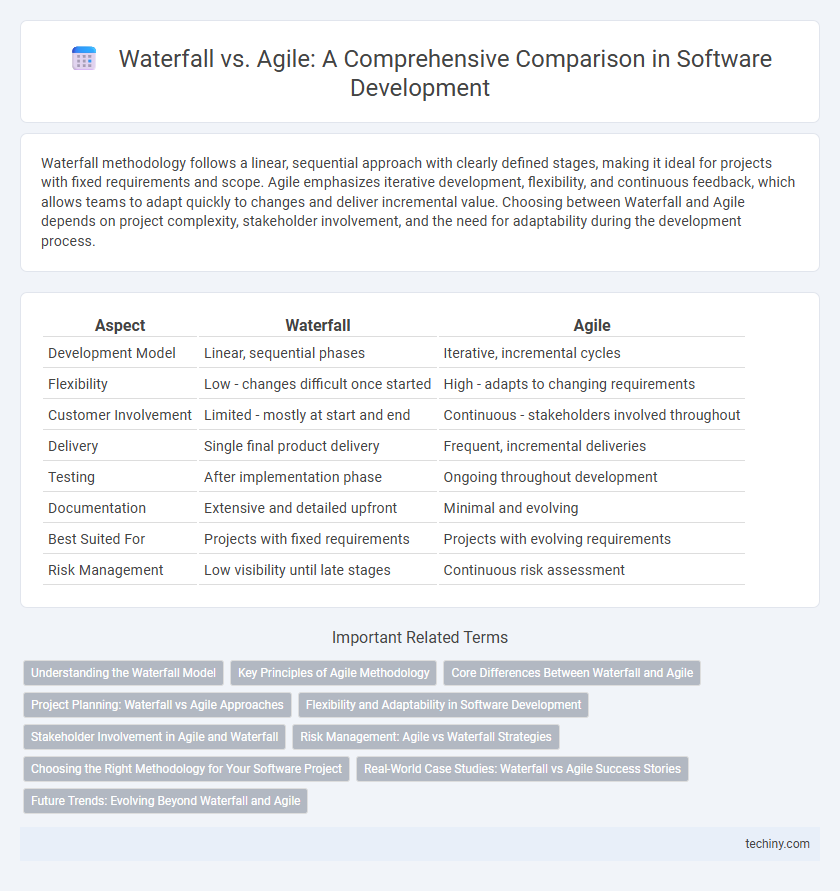Waterfall methodology follows a linear, sequential approach with clearly defined stages, making it ideal for projects with fixed requirements and scope. Agile emphasizes iterative development, flexibility, and continuous feedback, which allows teams to adapt quickly to changes and deliver incremental value. Choosing between Waterfall and Agile depends on project complexity, stakeholder involvement, and the need for adaptability during the development process.
Table of Comparison
| Aspect | Waterfall | Agile |
|---|---|---|
| Development Model | Linear, sequential phases | Iterative, incremental cycles |
| Flexibility | Low - changes difficult once started | High - adapts to changing requirements |
| Customer Involvement | Limited - mostly at start and end | Continuous - stakeholders involved throughout |
| Delivery | Single final product delivery | Frequent, incremental deliveries |
| Testing | After implementation phase | Ongoing throughout development |
| Documentation | Extensive and detailed upfront | Minimal and evolving |
| Best Suited For | Projects with fixed requirements | Projects with evolving requirements |
| Risk Management | Low visibility until late stages | Continuous risk assessment |
Understanding the Waterfall Model
The Waterfall Model is a linear and sequential approach to software development, where each phase such as requirements, design, implementation, testing, and maintenance is completed before the next begins. This model emphasizes thorough documentation, fixed project scope, and defined deliverables at each stage, making it suitable for projects with well-understood requirements. Understanding the Waterfall Model helps in identifying when a structured and disciplined development process is preferable over iterative and flexible methodologies like Agile.
Key Principles of Agile Methodology
Agile methodology emphasizes iterative development, continuous feedback, and adaptive planning to enhance flexibility and respond quickly to changing requirements. It prioritizes customer collaboration, working software, and cross-functional team communication to deliver high-quality products efficiently. Key principles include valuing individuals and interactions over processes, embracing change throughout the project lifecycle, and delivering functional software frequently.
Core Differences Between Waterfall and Agile
Waterfall follows a linear and sequential approach where each phase must be completed before the next begins, emphasizing thorough documentation and fixed requirements. Agile promotes iterative development with continuous feedback, allowing flexibility and adaptability through sprints and regular stakeholder collaboration. The core difference lies in Waterfall's rigid structure versus Agile's dynamic and incremental process.
Project Planning: Waterfall vs Agile Approaches
Waterfall project planning follows a linear, sequential process with distinct phases such as requirements, design, implementation, and testing, ensuring thorough documentation and fixed timelines. Agile project planning emphasizes iterative development, continuous feedback, and flexibility, allowing teams to adapt to changing requirements through sprints and regular stakeholder collaboration. Waterfall suits projects with clear, unchanging objectives, while Agile excels in dynamic environments requiring rapid delivery and incremental improvements.
Flexibility and Adaptability in Software Development
Waterfall methodology offers a linear and structured approach, making it less flexible in accommodating changes once the project is underway. Agile emphasizes iterative development and continuous feedback, enabling teams to adapt quickly to evolving requirements and market conditions. This flexibility makes Agile particularly suited for dynamic environments where software needs frequently change.
Stakeholder Involvement in Agile and Waterfall
Stakeholder involvement in Agile is continuous and collaborative, promoting regular feedback through iterative sprints and ceremonies like sprint reviews, ensuring the product evolves according to user needs. In contrast, Waterfall involves stakeholders primarily at the initial requirements gathering phase and the final delivery, limiting their influence during the development cycle. Agile's adaptive approach increases stakeholder satisfaction by incorporating changes rapidly, whereas Waterfall's linear process often leads to delayed adjustments and potential misalignment with stakeholder expectations.
Risk Management: Agile vs Waterfall Strategies
Agile methodologies prioritize continuous risk assessment through iterative development and frequent stakeholder feedback, enabling early detection and mitigation of potential issues. Waterfall follows a linear, sequential approach where risks are identified primarily during the initial planning phase, often leading to increased exposure if unforeseen problems arise later. Agile's flexible adaptability reduces project risk by accommodating changing requirements, whereas Waterfall's rigid structure can result in delayed responses to project uncertainties.
Choosing the Right Methodology for Your Software Project
Selecting the appropriate software development methodology hinges on project scope, complexity, and flexibility requirements, with Waterfall offering a linear, structured approach ideal for well-defined projects, while Agile emphasizes iterative progress and adaptability suited for evolving requirements. Teams prioritizing customer feedback and incremental delivery benefit from Agile's sprint-based cycles and collaborative frameworks like Scrum or Kanban. Conversely, projects with fixed timelines and stable specifications might achieve efficiency through Waterfall's sequential phases and clear milestone checkpoints.
Real-World Case Studies: Waterfall vs Agile Success Stories
Real-world case studies reveal that Agile methodologies significantly enhance project adaptability and stakeholder collaboration, as demonstrated by Spotify's iterative development process leading to rapid feature releases and user satisfaction. In contrast, large government projects like the US Department of Defense have historically employed Waterfall approaches, ensuring strict compliance and documentation but often encountering delays and inflexibility. Success stories highlight Agile's superiority in dynamic environments, while Waterfall remains effective in projects with well-defined, stable requirements.
Future Trends: Evolving Beyond Waterfall and Agile
Future trends in software development emphasize hybrid methodologies that merge the structured planning of Waterfall with Agile's adaptability, driving more efficient and flexible project delivery. Emerging technologies like AI-powered project management tools and advanced collaboration platforms are transforming traditional workflows, enabling real-time adjustments and predictive analytics. Continuous integration and deployment practices will further evolve, fostering faster innovation cycles while maintaining robust quality assurance standards beyond conventional Waterfall and Agile frameworks.
Waterfall vs Agile Infographic

 techiny.com
techiny.com